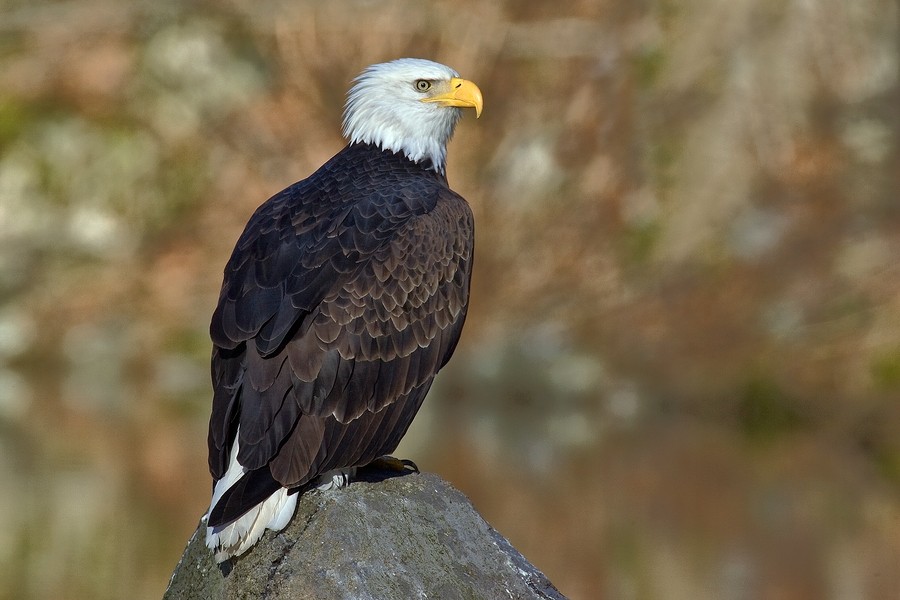Bald Eagle
A species of Sea eagles, Also known as Bird Of Washington, American Eagle Scientific name : Haliaeetus leucocephalus Genus : Sea eagles
Bald Eagle, A species of Sea eagles
Also known as:
Bird Of Washington, American Eagle
Botanical name: Haliaeetus leucocephalus
Genus: Sea eagles
Content
Description People often ask General Info
 Photo By Alan D. Wilson, www.naturespicsonline.com , used under CC-BY-SA-2.0 /Cropped and compressed from original
Photo By Alan D. Wilson, www.naturespicsonline.com , used under CC-BY-SA-2.0 /Cropped and compressed from original Description
The national symbol of the United States, the large, distinctively white-headed bald Eagle has a deep sense of symbolism and meaning for that country. It’s no wonder why it was chosen for the role. The bald Eagle is regal, formal, and inspiring to see. It’s incredibly strong and very dangerous to its prey.
Size
79 - 94 cm
Life Expectancy
15-47 years
Nest Placement
Tree
Clutch Size
1 - 3 eggs
Incubation Period
1 brood
Number of Broods
34 - 36 days
Nestling Period
56 - 98 days
Feeding Habits
Bald Eagle's diet primarily includes fish (56%), such as salmon and herring, but also birds (28%), mammals (14%), and other prey (2%). They exhibit opportunistic feeding behaviors, consuming prey live, fresh, or as carrion, and are known to gorge or fast for extended periods.
Habitat
Bald Eagle thrive in North American wetlands, including seacoasts, riverbanks, lakes, and marshes. Their ideal habitats feature open waters abundant with fish, surrounded by old-growth forests or trees suitable for nesting and roosting. They prefer tall trees that offer wide views, aiding their hunting activities. Bald Eagle are adaptable and can occupy open terrains with prairies or meadows, especially where water is accessible for fishing in winter.
Nest Behavior
Both bald Eagle parents contribute materials, but the female primarily arranges them. They may spend up to three months building or refurbishing their nests. Egg-laying follows the completion of the nest, and both parents share in incubation and rearing of the young.
Nest Characteristics
Bald Eagle selects tall and sturdy trees to nest in, usually conifers that tower above the forest canopy. The nests are impressively large, averaging 5 to 6 feet across and 2 to 4 feet tall, and can have varying shapes from cylindrical to conical to flat. Construction materials include sticks, grass, moss, and feathers for lining the interior.
Dite type
Piscivorous
People often ask
General Info
Feeding Habits
Bird food type
Bird Feeder Type

Platform
Sounds
Call
Recording location: United States
Behavior
Bald Eagle exhibit remarkable flying capabilities, engaging in soaring, gliding, and flapping across distances. Notably, their courtship includes a dramatic aerial display where pairs interlock talons in a spiraling descent, releasing just before impact. Notorious for kleptoparasitism, bald Eagle will intimidate other birds and even mammals to pilfer meals. On land, their movement appears clumsy, yet they're adept at floating and 'rowing' with wings on water. In colder seasons, bald Eagle forms large, noisy congregations at roosts and feed sites, often aggressively competing for food. Territorial during mating season, they fend off various animals. At food sources, they will dominate over vultures but engage in tense standoffs with other scavengers.

 Photo By Alan D. Wilson, www.naturespicsonline.com , used under CC-BY-SA-2.0 /Cropped and compressed from original
Photo By Alan D. Wilson, www.naturespicsonline.com , used under CC-BY-SA-2.0 /Cropped and compressed from original